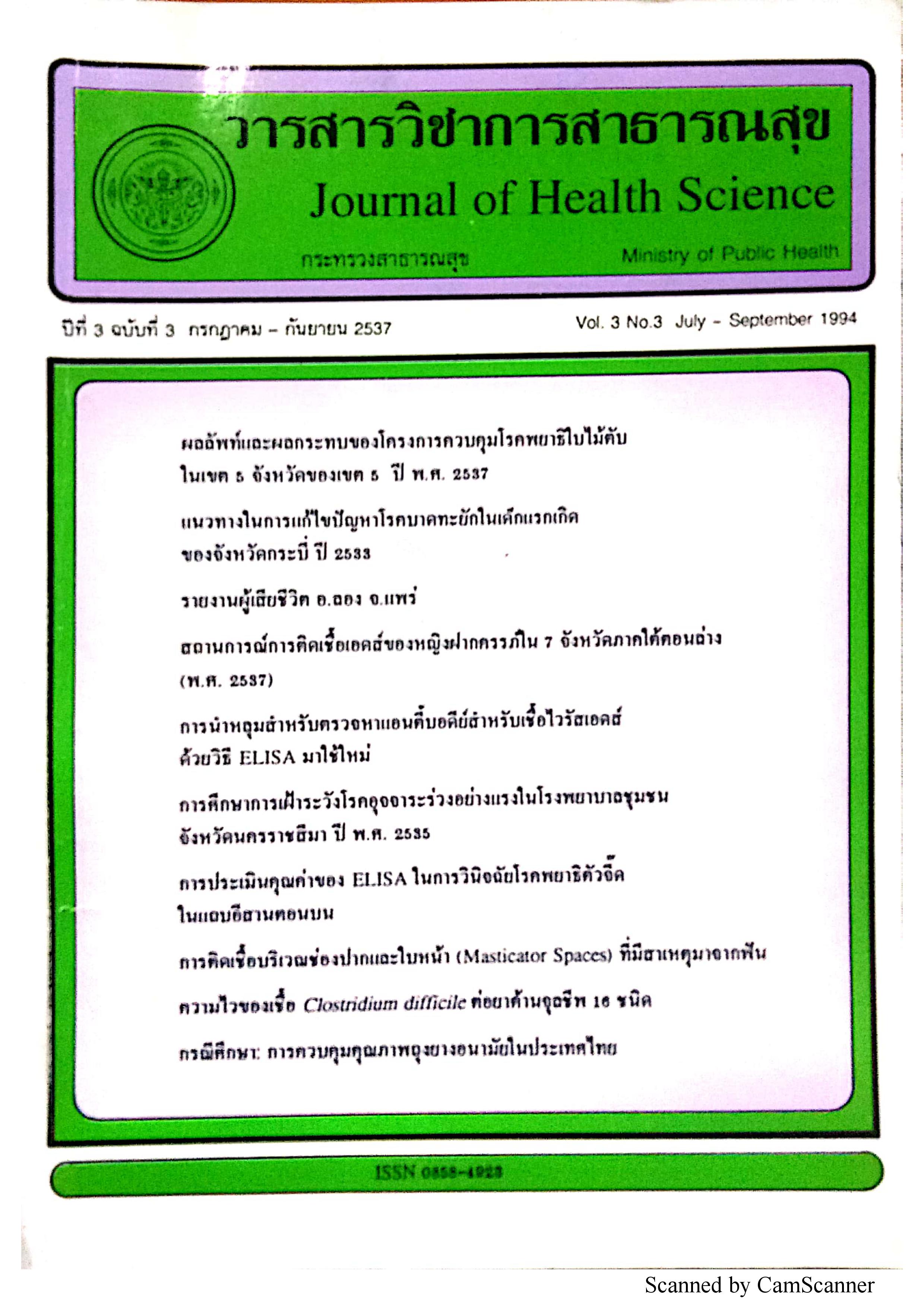ผลลัพธ์และผลกระทบของโครงการควบคุมโรคพยาธิใบไม้ตับใน 5 จังหวัดของเขต 5 ปี พ.ศ.2537
บทคัดย่อ
การวิจัยครั้งนี้มีวัตถุประสงค์ เพื่อศึกษาผลลัพธ์และผลกระทบของโครงการควบคุมโรคพยาธิใบไม้ตับ ในรอบครึ่งปีของแผนพัฒนาการสาธารณสุข ฉบับที่ 7 ใน 5 จังหวัดของเขต 5 คือ นครราชสีมา ชัยภูมิ บุรีรัมย์ สุรินทร์ ศรีสะเกษ เป็นการวิจัยเชิงสำรวจโดยการสุ่มตรวจอุจจาระหาไข่พยาธิและความรุนแรงของการติดโรคพยาธิ จาก 5,947 ตัวอย่าง และสัมภาษณ์ตัวอย่างจำนวน 1,200 ตัวอย่าง รวมทั้งศึกษาวิเคราะห์ผลการปฏิบัติงานของเจ้าหน้าที่สาธารณสุขในจังหวัดที่รับผิดชอบ ผลการศึกษา พบอัตราความชุกของการเป็นโรคพยาธิใบไม้ตับร้อยละ 8.42 ซึ่งต่ำกว่าเป้าหมาย และลดลงประมาณ 2 เท่า เมื่อเทียบกับการสำรวจในปี พ.ศ.2534 ระดับความรุนแรงอยู่ในเกณฑ์ต่ำ ส่วนระดับความรู้เกี่ยวกับโรคพยาธิใบไม้ตับ ยังไม่ดีเท่าที่ควร ระดับเจตคติต่อโรคหนอนพยาธิ เป็นบวก พฤติกรรมการกินที่ถูกต้อง มีเพียงร้อยละ 41.82 การใช้ส้วมเป็นประจำมีเพียงร้อยละ 36.15 การได้รับความรู้และข่าวสารจากสื่อประเภทต่างๆ พบเพียงร้อยละ 71.33 ของหลังคาเรือน หอกระจายข่าวเป็นสื่อที่ดีที่สุด ส่วนเอกสาร/แผ่นพับ/โปสเตอร์ เข้าถึงประชาชนน้อยทีสุด
จากการวิเคราะห์ความสัมพันธ์ พบว่า พฤติกรรมการกินปลาดิบ และระดับความรู้โรคพยาธิใบไม้ตับมีความสัมพันธ์กับการตรวจพบไข่พยาธิอย่างมีนัยสำคัญทางสถิติ (p<0.05) และการได้รับความรู้และข่าวสารจากสื่อประเภทต่างๆ มีความสัมพันธ์กับระดับความรู้เกี่ยวกับโรคพยาธิใบไม้ตับเช่นกัน (p<0.0001)
จากผลการศึกษาสรุปได้ว่าการปฏิบัติงานควบคุมโรคพยาธิใบไม้ตับมีผลกระทบทำให้ความชุกและความรุนแรงของโรคลดลง แต่ยังจะต้องดำเนินการต่อไป โดยเฉพาะการแก้ไขพฤติกรรมการกิน การใช้ส้วม และการให้สุขศึกษาทั้งแนวกว้างและแนวลึกในรูปแบบที่เข้าถึงประชาชนมากที่สุด โดยดำเนินการร่วมไปกับการค้นหาผู้ป่วยและให้การรักษาตามแนวทางที่กำหนดไว้ อย่างต่อเนื่อง
Downloads
ดาวน์โหลด
เผยแพร่แล้ว
วิธีการอ้างอิง
ฉบับ
บท
การอนุญาต
ลิขสิทธิ์ (c) 1994 กระทรวงสาธารณสุข

This work is licensed under a Creative Commons Attribution-NonCommercial-NoDerivatives 4.0 International License.







